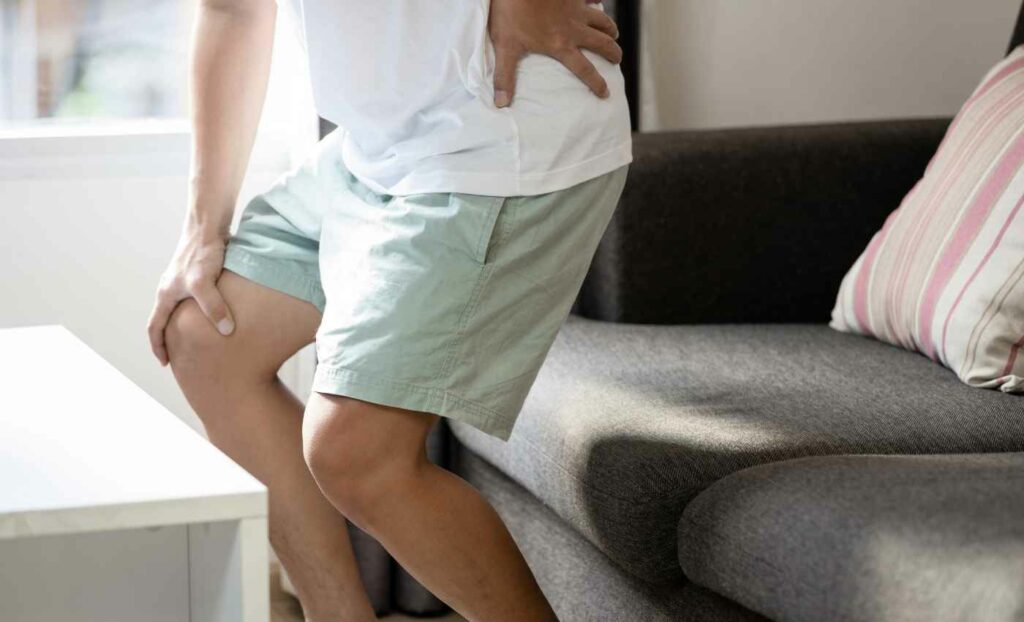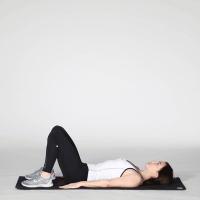Waist pain is a common complaint among men, and it can stem from various underlying causes. While it’s crucial to remember that only a healthcare professional can provide a definitive diagnosis and treatment plan, understanding the potential reasons for waist pain can be beneficial. In this blog, we’ll delve into the causes, symptoms, and management of waist pain in men, offering valuable insights to help individuals navigate this discomfort with greater awareness and knowledge.
Contents
Common Causes Of Waist Pain In Men
Understanding the common causes of waist pain in men can help individuals identify the source of their discomfort and seek medical attention when needed. Here are some causes of waist pain in men:
- Muscle Strain: Overexertion, lifting heavy objects improperly, or sudden movements can strain the muscles around the waist, leading to pain. Poor posture during prolonged sitting or standing can also contribute to muscle strain.
- Back Problems: Waist pain often originates from issues with the spine. Conditions like herniated discs, spinal stenosis, sciatica, or spondylosis can lead to discomfort in the lower back and waist region.
- Kidney Stones: The formation of kidney stones can cause excruciating pain, typically originating in the lower back or waist area and radiating to the abdomen and groin. Passing a kidney stone can be extremely painful.
- Digestive Disorders: Gastrointestinal problems such as constipation, gas, irritable bowel syndrome (IBS), or diverticulitis can result in referred pain in the waist region due to irritation or inflammation of the digestive tract.
- Abdominal Conditions: Conditions affecting the abdominal organs, including appendicitis, pancreatitis, or gallbladder issues, may manifest as waist pain. These conditions often require urgent medical attention.
- Infections: Infections like urinary tract infections (UTIs) or pelvic inflammatory disease (PID) can cause pain in the lower abdomen and waist area. These infections may also present with other symptoms like fever or urinary urgency.
- Musculoskeletal Conditions: Disorders like osteoarthritis or ankylosing spondylitis can cause chronic pain in the waist and lower back due to joint degeneration or inflammation.
- Trauma or Injury: Accidents, falls, or sports-related injuries can lead to injuries in the waist area, causing acute pain.
- Referred Pain: Some medical conditions, like heart disease or pneumonia, can cause referred pain that is felt in the waist area, even though the issue is not directly related to the waist.
Exercises To Relieve Waist Pain In Men
Waist pain can often be alleviated and prevented through regular exercise routines that focus on strengthening the core muscles, improving flexibility, and maintaining proper posture. Here are some effective exercises for men to relieve and prevent waist pain:
Plank
- Start in a push-up position with your arms extended and hands directly under your shoulders.
- Keep your body in a straight line from head to heels, engaging your core muscles.
- Hold the plank position for as long as you can, aiming to increase your endurance over time.
Cat-Cow Stretch
- Get on your hands and knees in a tabletop position.
- Inhale, arch your back and lift your head (Cow Pose).
- Exhale, round your spine, and tuck your chin (Cat Pose).
- Flow between these two positions for 1-2 minutes.
Child’s Pose
- Kneel on the floor with your big toes touching and knees apart.
- Sit back on your heels and extend your arms forward, lowering your chest toward the floor.
- Hold this stretch for 30 seconds to 1 minute, focusing on deep breaths.
Side Planks
- Lie on your side with your legs extended and prop yourself up on your elbow.
- Lift your hips off the ground, creating a straight line from head to heels.
- Hold for 20-30 seconds on each side, gradually increasing the duration.
Bridges
- Lie on your back with knees bent and feet hip-width apart.
- Lift your hips off the ground, creating a straight line from your shoulders to your knees.
- Squeeze your glutes at the top and hold for a few seconds.
- Lower your hips and repeat for 10-15 repetitions.
Supermans
- Lie facedown on the floor with arms extended overhead and legs straight.
- Lift your arms, chest, and legs off the ground simultaneously, engaging your lower back muscles.
- Hold for a few seconds, then lower back down. Repeat 10-15 times.
Seated Twists
- Sit on the floor with your legs extended.
- Bend one knee and cross it over the other leg, placing your foot on the floor.
- Twist your torso to the opposite side, using your arm to gently push against your bent knee.
- Hold for 15-30 seconds on each side.
Leg Raises
- Lie on your back with your legs straight.
- Lift both legs off the ground, keeping them together and engaging your lower abdominal muscles.
- Lower your legs slowly without touching the ground, then lift them again. Repeat 10-15 times.
Pelvic Tilts
- Lie on your back with your knees bent and feet flat on the floor.
- Tighten your abdominal muscles and press your lower back into the floor, tilting your pelvis upward.
- Hold for a few seconds, then release. Repeat 10-15 times.
Effective Treatment Options For Men’s Waist Pain Relief
The choice of treatment for waist pain in men depends on the specific cause of the pain. Here are some effective options for men’s waist pain relief:
- Rest and Activity Modification: For waist pain caused by muscle strain or overuse, the initial treatment often involves rest and avoiding activities that worsen the pain. Giving the affected muscles time to heal is essential.
- Pain Medications: Over-the-counter pain relievers like non-steroidal anti-inflammatory drugs (NSAIDs) can help reduce pain and inflammation associated with muscle strain, musculoskeletal conditions, or minor injuries. However, it’s crucial to use these medications as directed and consult a healthcare provider if the pain persists.
- Physical Therapy: A physical therapist can design a personalized exercise program to strengthen the core, improve posture, and alleviate waist pain. These exercises may focus on the abdominal, back, and hip muscles to provide better support to the spine and waist.
- Heat and Cold Therapy: Applying heat packs or ice packs to the affected area can help reduce muscle spasms, ease pain, and improve blood flow. Heat is typically more beneficial for muscle-related pain, while cold therapy may be more suitable for acute injuries.
- Prescription Medications: In cases of severe pain due to conditions like herniated discs or nerve compression, healthcare providers may prescribe stronger pain medications, muscle relaxants, or anti-seizure medications to manage pain and discomfort.
- Injections: Epidural steroid injections or nerve blocks may be considered for individuals with chronic back pain or nerve-related waist pain. These injections can provide temporary relief and reduce inflammation.
- Minimally Invasive Procedures: For specific spine-related issues like herniated discs, minimally invasive procedures such as microdiscectomy or epiduroscopy may be recommended when conservative treatments fail to provide relief.
- Surgery: In severe cases, surgical intervention may be necessary. Procedures like spinal fusion, discectomy, or laminectomy can address structural issues.
How Men Can Reduce The Risk Of Waist Pain
Preventing waist pain in men involves making lifestyle adjustments to minimize the risk of injury. Here are some essential preventive measures that men can incorporate into their daily routines:
- Maintain a Healthy Weight: Excess weight can strain the spine and lower back muscles, leading to waist pain. Men should strive to maintain a healthy weight through a balanced diet and regular exercise.
- Practice Proper Lifting Techniques: When lifting heavy objects, use your legs instead of your back to bear the load. Bend your knees, keep the object close to your body, and avoid twisting your torso while lifting.
- Maintain Good Posture: Poor posture can contribute to waist pain over time. Men should be mindful of their posture while sitting, standing, and walking. Ergonomic chairs and workstations can encourage proper posture.
- Take Breaks: If you have a sedentary job or lifestyle, take regular breaks to stand up, stretch, and move around. Prolonged sitting can lead to muscle stiffness and discomfort.
- Use Proper Mattress and Pillow: Invest in a mattress and pillows that provide adequate support for your spine while sleeping. An ergonomically designed mattress can help maintain proper spinal alignment.
- Quit Smoking: Smoking can contribute to decreased blood flow to spinal discs, potentially accelerating degeneration. Quitting smoking can have a positive impact on overall musculoskeletal health.
- Avoid Excessive Alcohol: Excessive alcohol consumption can lead to nutritional deficiencies that may affect your health. Moderation is key to maintaining a healthy lifestyle.
- Regular Check-ups: Schedule regular check-ups with a healthcare provider to address any emerging musculoskeletal issues.
- Proper Footwear: Wear comfortable and supportive shoes that provide adequate arch support. Ill-fitting or unsupportive footwear can affect your posture and contribute to waist pain.
- Stay Informed: Educate yourself about proper body mechanics and ergonomics, especially if your job involves repetitive movements or prolonged sitting.
Conclusion
In conclusion, waist pain in men can be a debilitating issue, but it’s not something that should be endured in silence. By understanding the common causes, adopting preventive measures, and incorporating targeted exercises into your routine, you can manage and even prevent waist pain effectively.
Remember that maintaining a healthy lifestyle, including regular exercise, proper posture, and weight management, plays a crucial role in preventing waist pain. However, if you experience persistent or severe pain, it’s essential to consult with a healthcare provider to rule out any underlying medical conditions.
If you’re experiencing Back pain, physical therapy for back pain at PhysioMantra can help: Book an online physical therapy session.















